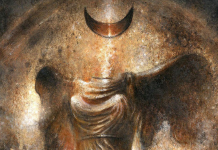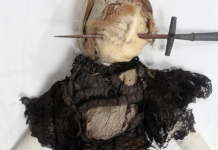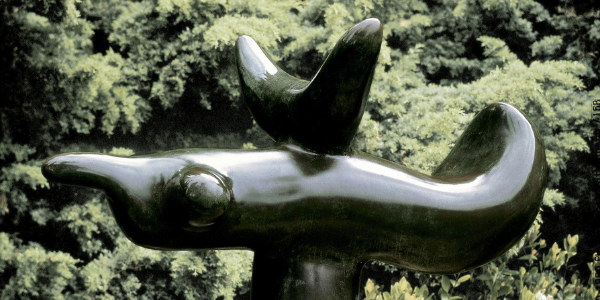
Surrealism is an art movement that sought to re-enchant the world by accessing creativity that was hidden away in an age of science and reason. What started as a political movement grew into a mission to break society free of explaining away of anything out of the ordinary.
As we learned in the first instalments of this series, “Introduction to Surrealism: An occultnik art movement,” “Surrealism: Six occultnik painters and writers,” and “Automatic painting for witches,” this art movement can be considered occult because surrealists then and now strive to reveal that which is hidden — which is what the occult is all about.
We occultniks know there are worlds unseen, and many of us use magick to reveal the wonders and wisdom of these other realms. Surrealists provide glimpses through the Veil into fantastical worlds or into the shame of humanity. Surrealist art follows themes of jarring images and abstraction which enchants the viewer and forces them to think about things considered taboo — putting on facades, sexual appetite, and the fact that dreams are not merely imagined but separate realities.
This article will be formatted differently from the previous two. Rather than selecting a few artists to introduce and describe how they fall under the occultnik aspect of the movement, I will focus more on the themes and concepts behind surrealist sculpture and assemblage. It seems fitting, as surrealism took sculpture and flipped it on its head, creating an unprecedented method of art which continues to influence artists today.
Related: Mirror of the Marvelous, reviewed by Alanna Wright
Related: The Esoteric Secrets of Surrealism, reviewed by J Simpson
Surrealist sculpture
Surrealist sculpture is defined by two major themes: biomorphism and objet trouvé, or found objects, according to the Art Story’s article on surrealist sculpture. Both methods are the nonstrategic, automatic processes unique to surrealism. Biomorphism is when abstracted shapes and forms created through organic, emotional association. Objet trouve is the composition of “random items chosen intuitively without strategy or predetermination.”1 Both themes have works that may be classified as the uncanny, which is a concept in art associated with Sigmund Freud describing anxiety or strange feelings that are created by familiar objects in unfamiliar contexts.2
Surrealist sculpture and assemblage (three-dimensional art made from combinations of materials including found objects or non-traditional art materials) took this movement to a whole other level. Salvador Dali, a well-known surrealist, understood the implications of the rise of sculpture and use of three-dimensional objects in art. He wrote, “People were no longer limited to talking about their phobias, manias, feelings, and desires, but could now touch them, manipulate and operate them with their own hands.”3
Assemblage
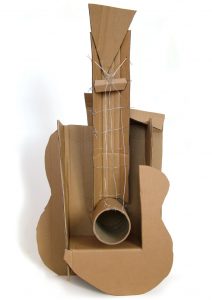
Assemblage is a kind of sculpture; art that is made by assembling random objects, usually everyday things, scavenged or purchased specially by the artist.4
This method was first used by Pablo Picasso in his cubist constructions in the early 20th century. This became the basis for surrealist sculpture, as the method of automatism could be employed to find said objects.
Related: Sortilége: A crow’s stash of divinatory odds and ends, by Monica Bodirsky
Related: A chat with Lupa about bones, by Psyche
Biomorphism
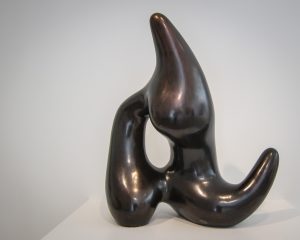
The term “biomorphic” came into use in the 1930s to describe surrealist paintings and sculptures that were abstract, yet referred to or evoked living forms such as the human body, or plants.5 The term was especially used to describe the works of Jean Arp and Joan Miro.
Biomorphic abstraction incorporates a visual language based on uncanny shapes (people recognize them on a primal level, but have never seen them before), often described as bulbous, sumptuous, and lush.6
In “The Role of Biomorphic Shapes in Abstract Art,” Phillip Barcio, states that biomorph breaks down to the Greek root words bio, meaning life, and morphe, meaning form. Barcio explained that surrealists had a “special connection” to the root word morphe. In Greek mythology, the god of sleep is Hypnos, and his son, the god of dreams, is Morpheus. With surrealism being based on the study of the subconscious and dreams, Barcio stated that “In that sense, it was the ultimate manifestation of biomorphism, as it relied on true automatism, the perfect expression of freedom and unforeseeable novelty, and it also inhabited the realm of Morpheus, the god of dreams.” ((Phillip Barcio, “The Role of Biomorphic Shapes in Abstract Art”, Ideel Art, 19 October 2016.))
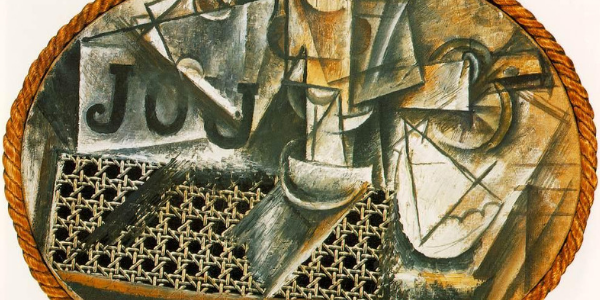
Objet trouvé: Found objects
Found objects can be natural or human-made objects — or pieces of objects — in which the artist sees some aesthetic value. The piece may be displayed as-is, or it may be manipulated slightly by the artist. The earliest known example of found objects dates back three million years to the Paleolithic era. The stone age artist found a stone shaped like a skull, and brought it three miles to their cave, where it was found millions of years later by archaeologists. The practice was later picked up by Pablo Picasso in 1912 when he created his piece “Still Life with Chair Canning.”
Dadaist and surrealist Marcel Duchamp fully developed the idea. He was still part of the Dada movement in 1917, but he joined the surrealist movement when it gained popularity in the 1920s and ’30s. He coined the term ready-made when he showcased his piece Fountain in 1917. Fountain was actually a urinal he placed on a baseboard.
Speaking of the 1930s, this was when surrealist sculptors of the time had further cultivated found objects, and identified subcategories for the concept:7
- Natural objects
- Interpreted natural objects
- Incorporated natural objects
- Mathematical objects
- Perturbed objects
- American objects
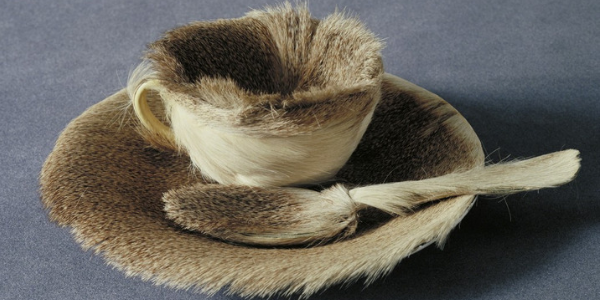
The uncanny
The concept of uncanny was first introduced in the essay “On the Psychology of the Uncanny” written in 1906 by German psychiatrist Ernst Jentsch. Jentsch defined uncanny as unheimlich — “unhomely” in German — which describes the phenomenon of seeing something new and unknown negatively.
Sigmund Freud, whom we know played a major role in the development of surrealism, repositioned the idea of uncanny to be something familiar and strange at the same time. For example, it’s uncanny when I change the paintings on my living room wall, because the different colours and subjects may open the room, or change the light.
Freud explained in his essay “The Uncanny” (1919) that heimlich can mean homely and familiar, but at the same time secret and concealed or private, while unheimlich was unknown and brought out something that was repressed. He called unheimlich “that class of frightening which leads back to what is known of old and long familiar.”8
Personally, the most jarring example of uncanny assemblage would have to be Meret Oppenheim’s Object (1936) — an ordinary teacup, saucer and spoon covered in gazelle fur. To me, it recalls images of mould, so I recoil every time I look at it.9
There is an interesting anecdote behind the creation of Object. Oppenheim was at a cafe with Pablo Picasso and Dora Maar (lucky!), and she was wearing a brass fur-covered bracelet that Picasso and Oppenheim were admiring and she said, “Almost anything can be covered in fur!” Later, when her tea went cold, she jokingly asked the waiter for “more fur.” This inside joke inspired Oppenheim to create Object. Supposedly, she went straight to a store to purchase the cup, saucer and spoon featured in the piece.10
Final thoughts
Surrealism had a major impact on modern art and continues to be seen across creative fields including film, literature, graphic design, fashion, and visionary art. This is a testament to the freedom unleashed by surrealism’s initial mission, whereby artists and writers may convey their own uniquely individual thoughts, feelings, and innermost drives through creative means. It loosened the field of possibilities and promised perpetual fodder to mine.11
As I had said in the first article introducing surrealism, I was sucked down a rabbit hole exploring this movement, finding more connections than I had expected to occulture. Surrealism not only influenced art, but freed people in general from the constraints of reason and science. There is much we owe to science and reason, but they are far from the only ways to live. I must say, a life of reason must be quite boring.
I am a 30 year old woman who is an ordained minister and I hold a bachelors degree with distinction in the field of sociology, but I believe in magick, fairies, and realms unseen. I believe I have surrealism to thank for the freedom to say that without fear of repercussion.
I hope you have enjoyed learning about this movement as much as I have! Until next time, my lovely readers!
Image credits: Sunbird by Joan Miro, Still Life with Chair Caning by Pablo Picasso, Object by Meret Oppenheim
- “Surrealist Sculpture Movement Overview and Analysis,” The Art Story, last modified 2018. [↩]
- “Art Terms: The Uncanny,” Tate.org, accessed on 19 December 2018. [↩]
- “Surrealist Sculpture Movement Overview and Analysis,” The Art Story, last modified 2018. [↩]
- “Art Term: Assemblage,” Tate.org, accessed on 19 December, 2018. [↩]
- “Art Terms: Biomorphic”, Tate.org, accessed on 22 December 2018. [↩]
- “Art Terms: Found Object,” Tate.org, accessed on 19 December 2018. [↩]
- “Found Objects: Definition, Characteristics, History of Objet Trouve,” Encyclopedia of Art Education, accessed on 20 December 2018. [↩]
- “Art Terms: The Uncanny,” Tate.org. [↩]
- Ed. note: I presented a paper on Meret Oppenheim’s surrealist objects at a conference in 2017, so if you’re interested in learning more about her work, I’m going to brashly recommend “The Materiality of Meret Oppenheim’s Surrealist Objects,” freely available to download. — Psyche [↩]
- Josh Rose, “Merit Oppenhiem, Object (Fur covered cup, saucer and spoon),” Khan Academy on Google Classroom (accessed 20 December 2018), 201. [↩]
- “Surrealist Sculpture Movement Overview and Analysis.” [↩]


